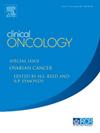Hypo-Fractionated Radiotherapy to the Cavity for Resected Brain Metastases: A UK Series
IF 3
3区 医学
Q2 ONCOLOGY
引用次数: 0
Abstract
Aims
With improved systemic disease control, the incidence of brain metastases in patients with cancer is increasing. Neurosurgical resection is recommended in selected cases, although local control following surgery remains an ongoing concern. Both fractionated radiotherapy and stereotactic radiosurgery (SRS) improve local control after surgical resection. Although postoperative SRS can avoid whole brain radiotherapy-associated toxicity, due to lack of survival and quality of life data, the optimum strategy remains debated. Furthermore, some cavities may be too large for SRS.
Materials and methods
In this multicentre study, patients following surgery for brain metastases were treated with a hypo-fractionated radiotherapy regimen (25Gy given in 5 fractions/30Gy in 6 fractions) to the surgical cavity.
Results
Sixty-five patients were identified from electronic patient notes with a median follow-up of 23.6 months (95% CI: 20.1–28.6). The 6-, 12-, 24- and 36-month freedom from local failure rates were 92.7% (95% CI: 81.7–97.2%), 77.3% (95% CI: 61.0–87.4%) and 70.6% (both 24- and 36-months, 95% CI: 52.9–82.5%), respectively. The 6-, 12- and 24-month overall survival rates were 80.0% (95% CI: 68.0–87.9%), 53.7% (95% CI: 40.6–65.2%) and 27.7% (95% CI: 16.0–40.7%), respectively. During follow-up, 10.8% (7/65 patients) developed leptomeningeal disease (LMD) and 3% (2/65 patients) developed radiation necrosis (RN). Treatment with hypo-fractionated radiotherapy to the surgical cavity was well tolerated; there was one episode of grade 3 toxicity (vomiting) in this patient cohort.
Conclusion
In this multicentre series of postoperative hypo-fractionated radiotherapy to the surgical cavity following resection of a brain metastasis, we demonstrated good rates of local control, with low risk of LMD and RN. Therefore, this radiotherapy regimen is a reasonable alternative to cavity SRS in patients with large cavity volumes or complete gross total resection within the UK. This should be investigated further within a prospective trial.
低分割腔放疗治疗脑转移瘤切除术:英国系列
随着全身性疾病控制的改善,癌症患者脑转移的发生率正在增加。虽然手术后的局部控制仍是一个持续关注的问题,但在某些病例中建议神经外科切除。分割放疗和立体定向放射外科(SRS)均可改善手术切除后的局部控制。尽管术后SRS可以避免全脑放疗相关的毒性,但由于缺乏生存和生活质量数据,最佳策略仍存在争议。此外,有些空腔对于SRS来说可能太大了。材料和方法在这项多中心研究中,脑转移手术后患者接受低分割放疗方案(25Gy分5次/30Gy分6次)至手术腔。结果从电子病历中识别出65例患者,中位随访23.6个月(95% CI: 20.1-28.6)。6、12、24和36个月的局部失败率分别为92.7% (95% CI: 81.7-97.2%)、77.3% (95% CI: 61.0-87.4%)和70.6%(24和36个月,95% CI: 52.9-82.5%)。6个月、12个月和24个月的总生存率分别为80.0% (95% CI: 68.0 ~ 87.9%)、53.7% (95% CI: 40.6 ~ 65.2%)和27.7% (95% CI: 16.0 ~ 40.7%)。随访期间,10.8%(7/65)患者发生轻脑膜病(LMD), 3%(2/65)患者发生放射性坏死(RN)。手术腔次分割放疗耐受良好;在该患者队列中有一次3级毒性发作(呕吐)。结论在脑转移切除术后的手术腔内进行多中心次分割放疗,我们显示了良好的局部控制率,LMD和RN的风险较低。因此,在英国,对于腔体积大或完全切除的患者,这种放疗方案是一种合理的替代腔SRS。这应该在前瞻性试验中进一步研究。
本文章由计算机程序翻译,如有差异,请以英文原文为准。
求助全文
约1分钟内获得全文
求助全文
来源期刊

Clinical oncology
医学-肿瘤学
CiteScore
5.20
自引率
8.80%
发文量
332
审稿时长
40 days
期刊介绍:
Clinical Oncology is an International cancer journal covering all aspects of the clinical management of cancer patients, reflecting a multidisciplinary approach to therapy. Papers, editorials and reviews are published on all types of malignant disease embracing, pathology, diagnosis and treatment, including radiotherapy, chemotherapy, surgery, combined modality treatment and palliative care. Research and review papers covering epidemiology, radiobiology, radiation physics, tumour biology, and immunology are also published, together with letters to the editor, case reports and book reviews.
 求助内容:
求助内容: 应助结果提醒方式:
应助结果提醒方式:


